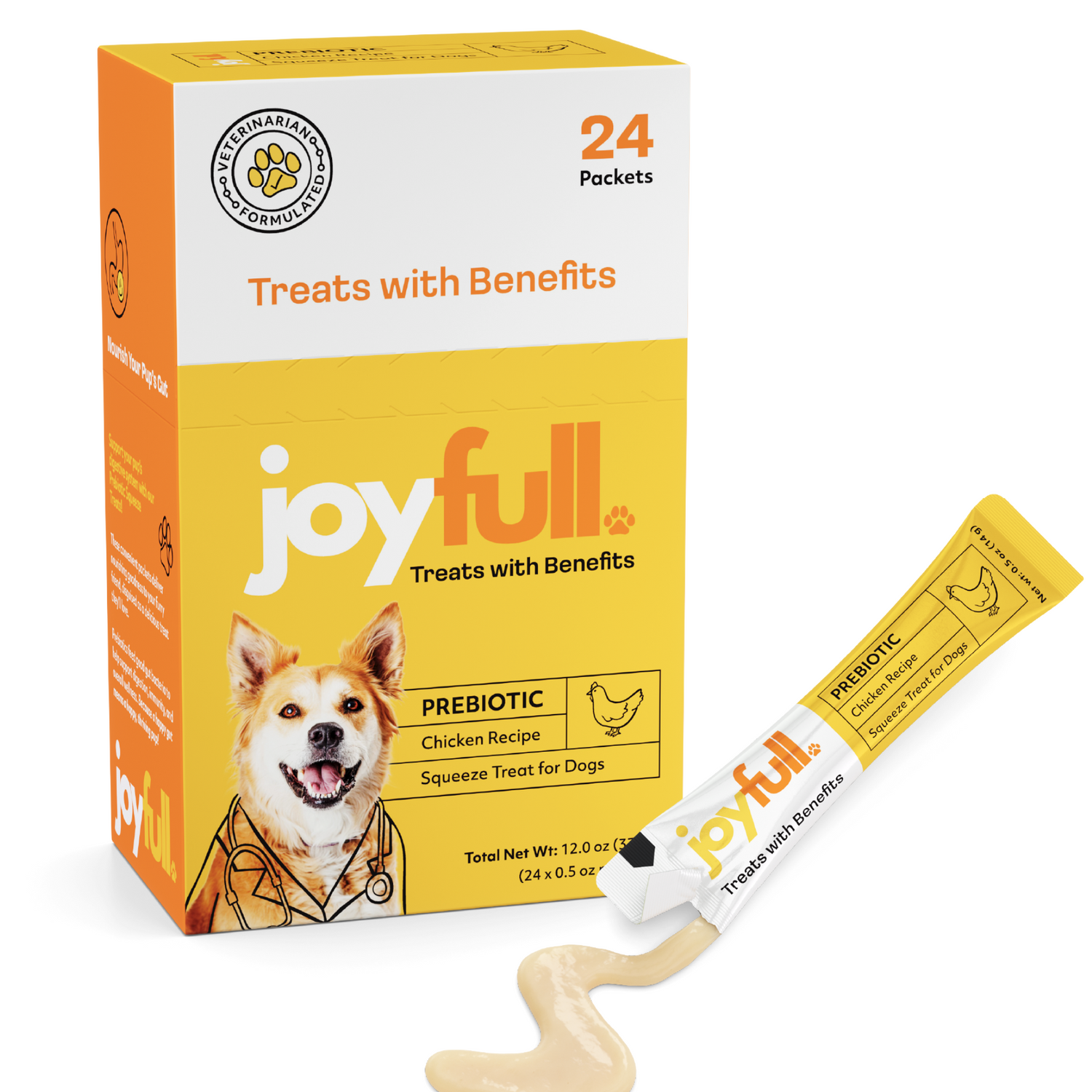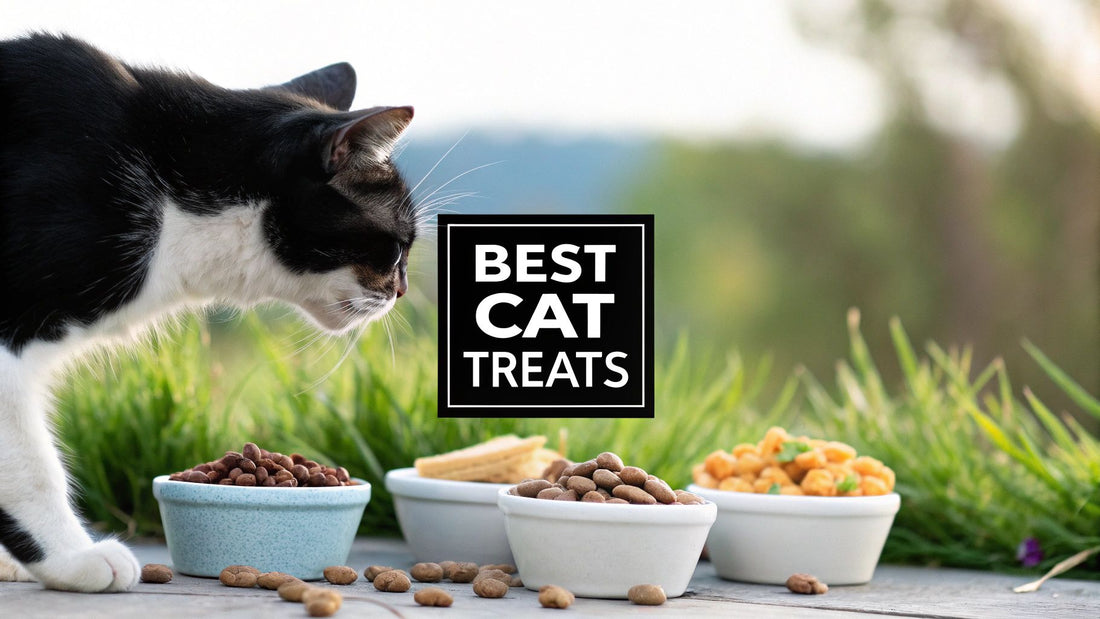
What Are the Best Cat Treats? A Complete Guide
When you're looking for the best cat treats, the secret is simple: look for a high-quality, named animal protein right at the top of the ingredient list. The best ones have very few fillers and absolutely no artificial additives. Think of treats as a supplement to your cat's main meals, not a replacement—they should never make up more than 10% of their daily calories.
What Makes a Cat Treat the Best Choice?
Walking down the pet food aisle can be dizzying. With so many cat treats on the shelves, how do you pick the right one? The best options are a perfect blend of a flavor your cat loves and nutrition that actually does them some good. It helps to think of a treat not just as a snack, but as a small, healthy bonus to their diet.
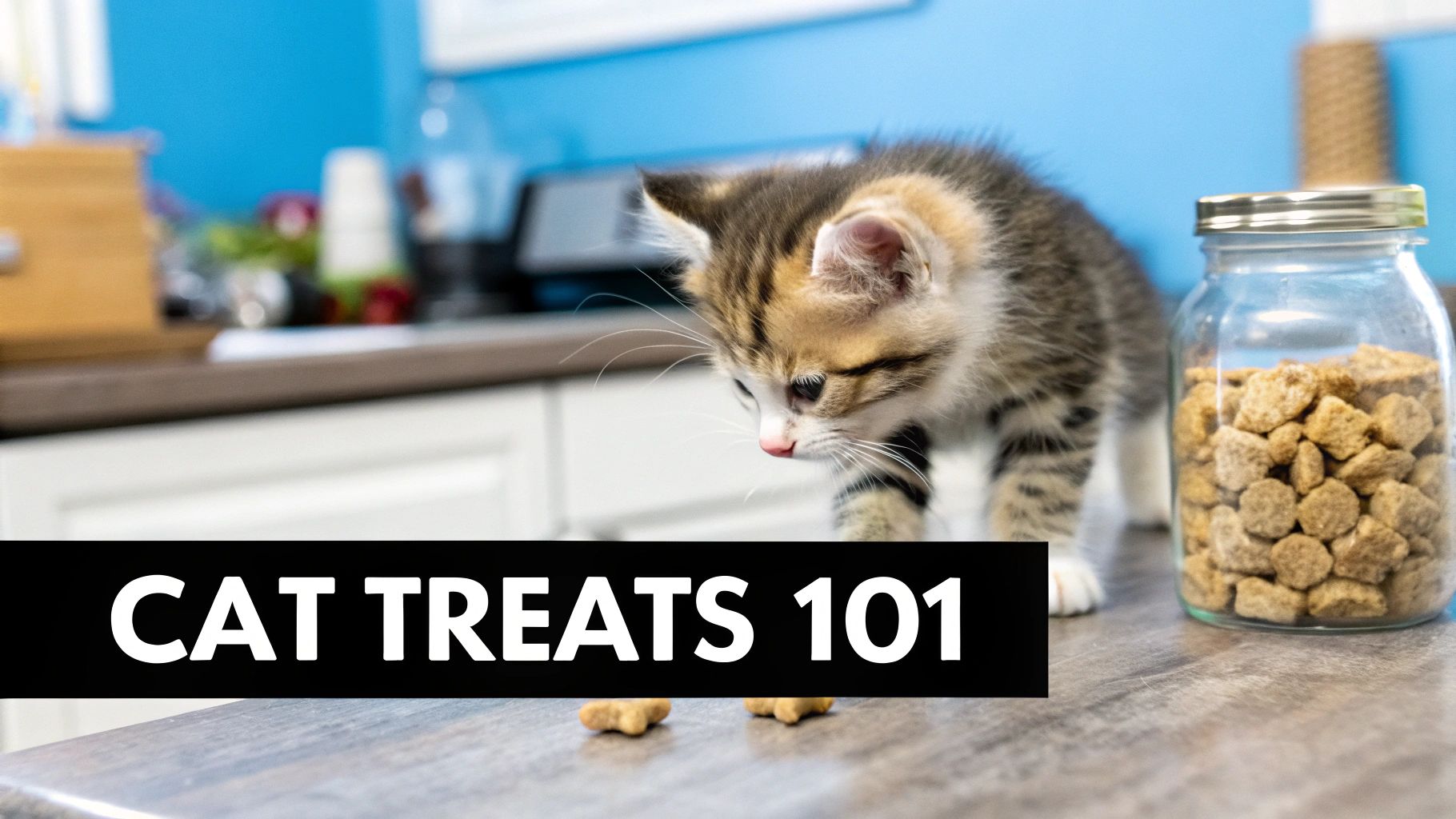
This guide will break down everything you need to know. We’ll cover how to read those tricky ingredient labels and understand how the right treat can genuinely support your cat’s health.
Beyond the Basic Snack
A great treat is so much more than just a tasty bite; it’s a tool. You can use it to reward good behavior, make your bond stronger, or even help with specific health issues like dental care or hairballs.
This shift in mindset from "snack" to "supplement" is shaking up the pet food industry. More and more cat owners are looking for premium treats that offer real benefits. In fact, the cat treat market is expected to hit USD 1.88 billion in the U.S. by 2025, and its sales are growing even faster than regular cat food. You can explore more on cat treat market trends to see just how big this change is.
We're here to clear up the confusion and help you make a choice that shows your cat just how much you care. Let this be your guide to becoming a pro at treating your cat the right way.
How to Read a Cat Treat Ingredient Label
Trying to figure out a cat treat label can feel like a pop quiz, but it’s actually pretty simple once you know the secret. The ingredients are listed by weight, so whatever you see first is what makes up most of the treat.
Since cats are obligate carnivores, they're designed to run on animal protein. That makes your job easy: the very first thing you should look for on the label is a specific, named animal protein.
The Good Stuff: Spotting High-Quality Ingredients
Think of it this way: "chicken" or "salmon" tells you exactly what you're giving your cat. Vague terms like "meat by-products," on the other hand, are a bit of a mystery box—they could be anything from organs to bone, and the quality is often questionable. Making sure a real, identifiable protein is at the top of the list is the single most important thing you can do.
Beyond that main protein, look for other beneficial ingredients. Things like healthy fats, especially omega fatty acids, are fantastic for giving your cat a shiny coat and healthy skin. You also want to see essential nutrients like taurine, which is absolutely vital for a cat's heart and eye health.
A great example would be a treat that lists salmon first, maybe followed by fish oil or even a little sweet potato for fiber. These are the kinds of ingredients that contribute to your cat's overall well-being. For a closer look at why this matters so much, you can explore the real benefits of high-protein cat treats.
The Bottom Line: A high-quality cat treat will always have a named animal protein as its #1 ingredient. This is the foundation of species-appropriate nutrition, supporting everything from strong muscles to healthy organs.
The Bad Stuff: Ingredients to Avoid on the Label
Knowing what not to look for is just as critical. Many treats on the market are packed with fillers that do little more than add bulk, offering almost zero nutritional value for a cat.
It's all about making every bite count. So, when you're scanning that label, here's a quick cheat sheet to help you sort the good from the not-so-good.
Decoding Cat Treat Ingredients
| High-Quality Ingredients to Look For | Low-Quality Ingredients to Avoid |
|---|---|
| Named Animal Proteins (e.g., Chicken, Salmon, Turkey) | Vague "Meat" or "By-Products" |
| Healthy Fats (e.g., Fish Oil, Chicken Fat) | Artificial Colors & Flavors (e.g., Red 40, Yellow 5) |
| Essential Nutrients (e.g., Taurine, Vitamins) | Chemical Preservatives (e.g., BHA, BHT, Ethoxyquin) |
| Natural Preservatives (e.g., Mixed Tocopherols) | Carbohydrate Fillers (e.g., Corn, Wheat, Soy) |
By keeping an eye out for these red flags, you can easily sidestep the junk and stick to the good stuff. It really makes a difference.
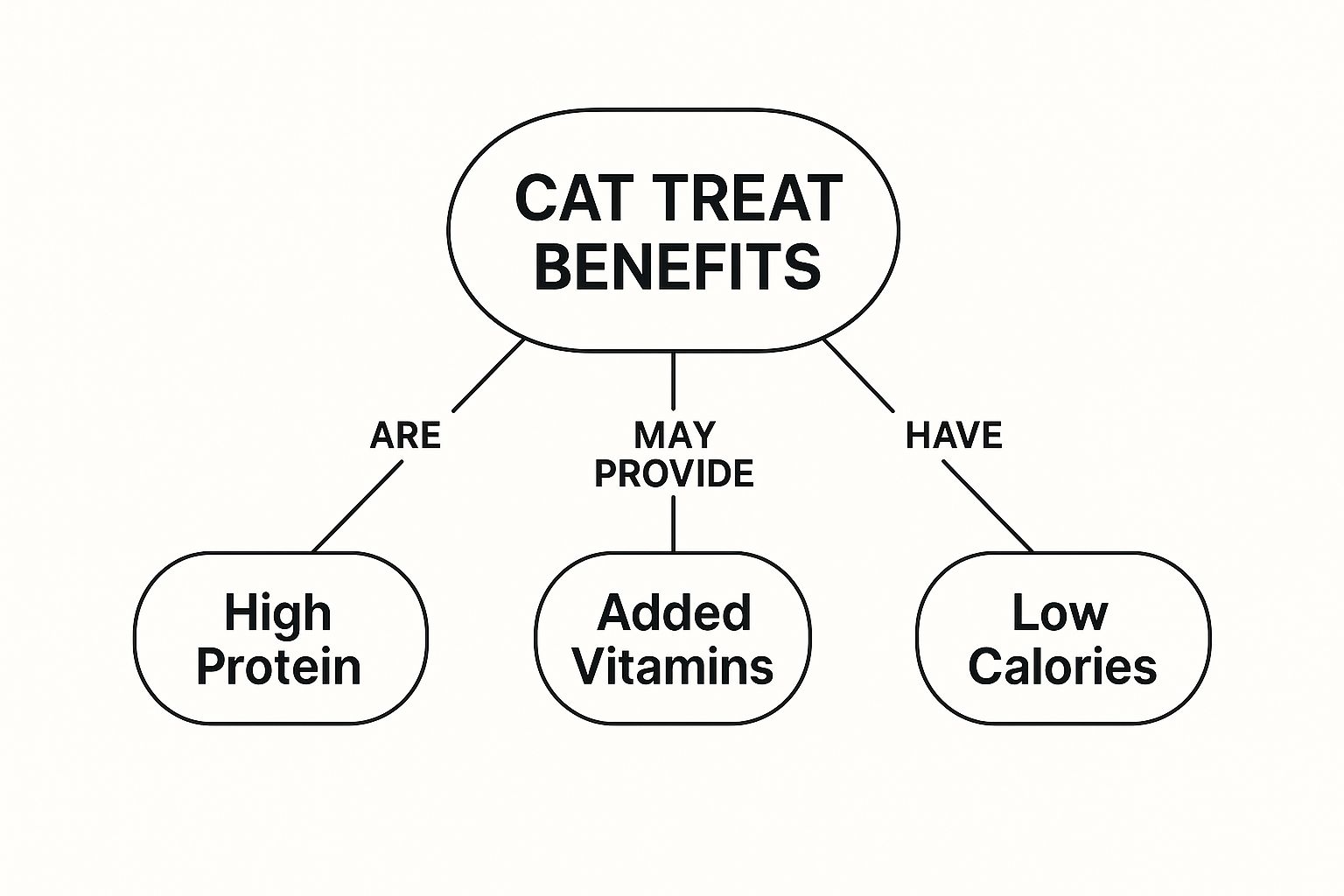
As you can see, the best treats are simple: they focus on high protein, beneficial vitamins, and a low-calorie count to keep your cat healthy and happy. Once you get the hang of spotting these key ingredients, you'll be able to make sure every treat you give is a good one.
Choosing the Right Type of Treat for Your Cat
Walk down the pet food aisle, and you'll see that not all cat treats are the same. It’s a lot like the snack aisle for people—some of us reach for crunchy pretzels, while others prefer a soft-baked cookie. Our cats have their own preferences, too, and picking the right treat means thinking about their age, dental health, and what they simply find delicious.
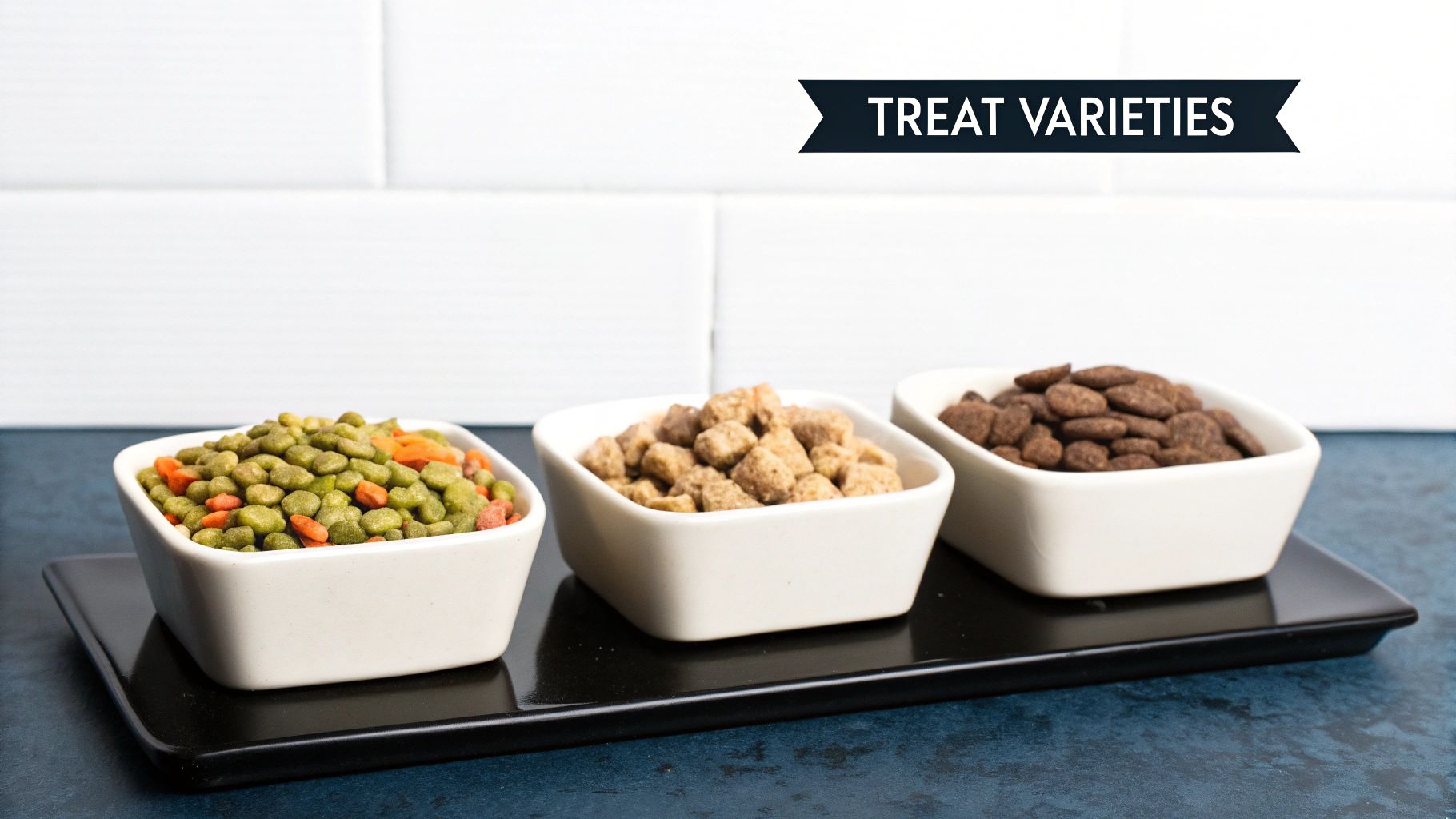
Let's break down the different kinds of treats out there, because each one offers something unique beyond just a tasty flavor.
Crunchy vs. Soft and Chewy Treats
Crunchy treats are probably what you picture first. They’re everywhere! That satisfying crunch actually serves a purpose. The rough texture creates friction on your cat's teeth, helping to scrape away some of the plaque and tartar that can build up over time. It's like a mini toothbrush in every bite.
On the flip side, soft and chewy treats are a lifesaver for many cats. Think about senior cats with sensitive gums or little kittens whose teeth are still coming in. The pliable texture is gentle and easy on their mouths, making them a go-to for even the fussiest eaters.
A treat's texture isn't just about preference; it's about function. For a young, healthy adult cat, a crunchy dental treat might be perfect. For an older cat with dental issues, a soft treat provides a painless way to enjoy a reward.
Freeze-Dried and Lickable Options
If you’re the kind of pet parent who reads every ingredient label, freeze-dried and dehydrated treats are your new best friend. These are as simple as it gets, often containing just one ingredient, like pure chicken or salmon. The freeze-drying process removes moisture but locks in all the nutrients and intense, natural flavor cats go crazy for. This purity makes them one of the best cat treats for picky eaters.
Then there are the lickable purées, which have exploded in popularity for some very good reasons. These treats, usually in a tube or pouch, are incredibly versatile.
- Increasing Hydration: They are packed with moisture, giving your cat's daily water intake a little boost.
- Administering Medication: Got a stubborn cat who won't take a pill? Hiding it in a tasty purée is a game-changer.
- Bonding: There’s something really special about hand-feeding your cat a lickable treat. It’s a great way to build a closer connection.
By getting to know these different options, you can find the perfect snack that truly fits your cat’s needs. If you want to dive deeper, you can learn more in our guide to healthy snacks for cats.
How Treats Can Actually Boost Your Cat's Health
Gone are the days when a treat was just a junk-food reward. The best treats on the market today are so much more—they’re what we call functional treats. Think of them less like candy and more like a delicious, targeted supplement that makes your cat’s health routine something they look forward to.
This idea of a treat that does something is a huge deal. It’s a major reason why the global pet snacks market is predicted to explode from USD 40.7 billion in 2024 to over USD 125 billion by 2034. That growth is coming from people like us who want to give our pets premium snacks that are genuinely good for them. You can dive deeper into the pet treat market trends to see just how much innovation is happening.
When you pick the right functional treat, you're supporting your cat's health in a way they’ll absolutely love.
What Kinds of Health Issues Can Treats Help With?
So, what exactly can a functional treat do? You might be surprised. Formulas now exist to help with some of the most common health hiccups cats face.
Here are a few of the most popular types you’ll find:
- Dental Health Treats: These are usually designed with a special crunchy texture. As your cat chews, that texture helps scrub away plaque and tartar buildup. Simple but effective.
- Hairball Control Treats: Nobody likes dealing with hairballs. These treats are packed with extra fiber to help keep everything moving smoothly through the digestive system, so ingested fur passes right on through.
- Joint Support Treats: A game-changer for older cats. These often include ingredients like glucosamine and chondroitin, which help keep their joints comfortable and support mobility.
- Urinary Health Treats: Urinary tract issues are unfortunately common in cats. Specialized treats can help maintain a healthy pH balance and support overall urinary wellness. We have a whole guide on cat treats for urinary health if you want to learn more.
The Big Idea: Functional treats turn a simple reward into a proactive health tool. They give you an easy way to support your cat's well-being—from their teeth to their tummy—with something they’ll happily gobble up.
Choosing a functional treat isn't just about spoiling your cat. It's an investment in their long-term health, one tasty bite at a time.
We all love spoiling our cats, and what better way than with a tasty treat? But to keep them healthy and happy, we need to treat them thoughtfully. The single most important rule to live by is the 10% rule.
Think of it this way: treats are the dessert of your cat's diet. They're a special indulgence, not a main course. That's why treats should make up no more than 10% of their total daily calorie intake.
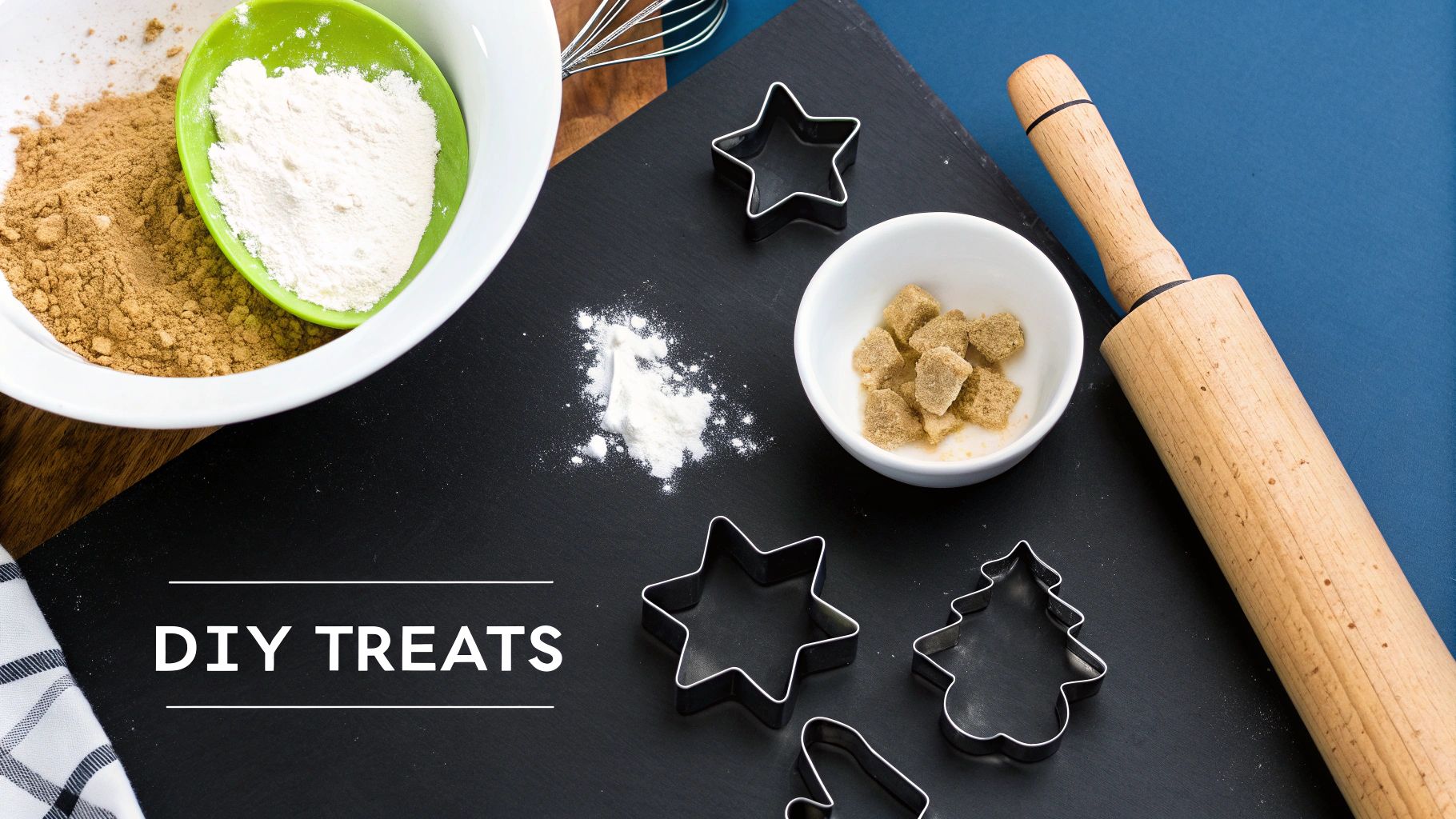
Stick to this, and you'll avoid the common pitfalls of weight gain or nutritional imbalances. Your cat's regular food is carefully formulated to give them everything they need, so overdoing it on the snacks can throw that balance out of whack. Just check the calorie info on the treat packaging and their food bag to stay on track.
Making Sure Treat Time is Safe Time
Treats can be fantastic tools for positive reinforcement. However, for bigger behavioral issues like shredding the sofa, you'll need more than a tasty morsel. Sometimes, practical solutions like cat scratch couch protectors are a necessary part of the training process.
It's also absolutely vital to know which foods are off-limits. Many of our favorite human snacks are downright dangerous for cats.
Here are a few common "people foods" you should never share with your feline friend:
- Onions, Garlic, and Chives: Even a small amount can damage their red blood cells.
- Chocolate: This is a big one. It contains theobromine, which is extremely toxic to cats.
- Grapes and Raisins: These have been linked to sudden kidney failure in pets.
- Alcohol and Caffeine: Both can wreak havoc on their nervous system and vital organs.
Whenever you introduce a new treat, start small. Give them just a tiny piece and keep an eye out for any allergic reactions or digestive issues like vomiting, diarrhea, or unusual itchiness.
Following these simple guidelines ensures that giving treats remains a joyful bonding experience. You can spoil your cat rotten without putting their health at risk.
Common Questions About Cat Treats
Even after diving into the world of cat treats, you might still have a few questions buzzing around. And that's completely normal. When it comes to picking the right snacks for our feline friends, the little details really do matter. Let's clear up some of the most common questions so you can feel good about the treats you choose.
After all, giving your cat a treat is a small act of love. Making sure you're doing it right helps keep that bond strong and your cat healthy for the long haul.
How Many Treats Can I Give My Cat Each Day?
This is the big one, isn't it? The best rule of thumb to follow is the 10% rule. It's a simple guideline: treats shouldn't make up more than 10% of your cat’s total daily calories.
For a typical 10-pound adult cat, that usually means keeping treats under 25 calories for the whole day. Always peek at the packaging—it'll tell you the calories per treat, which is key to knowing whether you can give one or a few.
Are Grain-Free Cat Treats a Better Option?
Not necessarily. The grain-free trend is everywhere, but it's not the most important thing to look for. What matters most is seeing a high-quality, named animal protein (like "chicken" or "salmon," not just "meat") as the very first ingredient.
A grain-free treat is only a must-have if your vet has diagnosed your cat with a specific grain allergy or sensitivity, which honestly, isn't very common. For most cats, a small amount of grain is no big deal. Focus on the meat content first.
Key Takeaway: Don't get hung up on the "grain-free" label. A recipe that puts high-quality protein first will always be a better choice for your cat's health.
When Can Kittens Start Eating Treats?
It's tempting to spoil a new kitten, but it’s best to hold off on treats until they're fully weaned and eating solid kibble without any issues. This usually happens around 8 to 10 weeks of age.
When you do start, look for treats made just for kittens. They're designed to be smaller, softer, and nutritionally balanced for a growing body. And just like with any new food, start slow and small to avoid upsetting their tiny tummies.
What Human Foods Are Safe Cat Treats?
While your cat might show a lot of interest in your dinner, most human foods are a no-go. A few exceptions are safe in very small, plain portions. Think tiny, unseasoned bits of cooked chicken, turkey, or fish. No salt, no oils, no bones—just the plain meat.
A little piece of plain, cooked egg can also be okay. But always be mindful of the long list of toxic foods for cats, like onions, garlic, chocolate, and grapes. When in doubt, it's always safer to stick with treats specifically formulated for felines.
At JoyFull, we build our treats around these very same principles. We start with high-quality protein, skip the unnecessary fillers, and always keep your cat's well-being front and center. Find a treat you can feel great about giving at https://joyfullpet.com.
